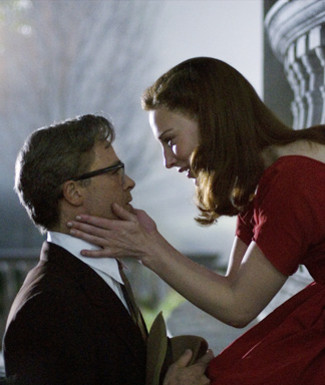
Putty Hill, a film by Matthew Porterfield (2010)
Something amazing is happening in the world of filmmaking. Crowdsourced funding mechanisms like Kickstarter.com are enabling a new generation of filmmakers to get a foothold doing what they love, where they want to do it. They’re using social media to find acting talent, and new digital camera technologies are making it possible to create amazing high quality films for a fraction of what it used to cost.
I’m particularly impressed by the work of Baltimore filmmaker Matthew Porterfield, whose films “Hamilton” (2006) and “Putty Hill” (2010) exemplify the new kind of “cinepreneurial” skillset which will certainly come to define 21st century filmmaking. (You can read here about the funding and creative process behind Putty Hill.)
Porterfield is a nice, unassuming guy who teaches film at Johns Hopkins and directs his students that if they want to make documentaries, they need to go to New York, and to go to Los Angeles for pretty much everything else. For today, this is sound advice. It’s the same kind of advice you’d give talented coders looking to unleash the next big web technology — go to San Francisco, because it’s where the industry is centered — at least right now.
But if you ask Porterfield why he doesn’t take his own advice, he’d likely offer a cryptic sort of answer — that he’d considered it but really couldn’t imagine himself anywhere else. I don’t know him well enough to speak for him, so I hope he weighs in here. But Matt and I are kindred spirits: we both are actively choosing place over anything else, and investing our time and talent to make it better.
Let’s Invest in Maryland Film, Not in Hollywood
Baltimore and Maryland have been the home to many well-known movie and television productions over the years, not the least of which have been Homicide: Life on the Street, The Wire, and a slew of Baltimore native Barry Levinson’s films including Diner, Tin Men, and Avalon. And most all of these productions received significant subsidies from the State of Maryland.
As budgets have continued to tighten, the O’Malley administration made a strategic decision to cut back on investment in film production subsidies. And that has probably been a very wise decision. Other states have been more than willing to outbid Maryland, offering ridiculous breaks. And Maryland really doesn’t need to be in yet another race to the bottom.

The Curious Case of Benjamin Button (2008)
The film The Curious Case of Benjamin Button (2008) was based on a short story by F. Scott Fitzgerald (who lived around the corner from me in Bolton Hill when he wrote it), and it was originally set in Baltimore (original text). Yet the film version was set in New Orleans and had a subtext about a dying woman retelling the story as Katrina bore down on the city. Why? Subsidies. New Orleans offered more subsidies than Maryland would. And so the story was changed and moved there. Who knows if the Katrina storyline was a condition in the contract!
I don’t really have an opinion about whether Benjamin Button should have been filmed in Baltimore, but I do have an opinion about engaging in zero-sum games with 49 other desperate states: it’s bad policy. And I also think the time has come to admit that big movie studios are the next big dinosaur to face extinction. Why should Sony or Disney or Universal make the bulk of the world’s content when every man, woman, and child has access to a $200 HD camera and a $999 post-production studio?
Investing in Cinepreneurs
John Waters is one of Baltimore’s great artistic assets. And it’s not because of film subsidies. His work is known worldwide, and it celebrates the quirky, distinctive voice of Baltimore. Matthew Porterfield is distinctive and quirky too, and he makes beautiful pictures: he’ll be next to make his mark. And there are dozens more teeming around places like MICA, the Creative Alliance CAMM Cage, Johns Hopkins, Towson University, and UMBC. We need only to nurture their talent and the ecosystem.
Another film, Browncoats: Redemption was made locally last year and created by local entrepreneurs Michael Dougherty and Steven Fisher. It is utilizing an innovative non-profit funding model. The film’s is raising money for five charities and it leveraged social media and Internet to recruit 160+ volunteers and market the film.
Instead of blowing money on Hollywood productions that bring little more than short term contract and catering work to Maryland, why don’t we instead start investing in the artists in our own backyard? Just as IT startups have gotten much cheaper to jumpstart, it’s now possible to make films for anywhere from $50 to $150K. If we dedicate between $5M and $7M to matching funds raised via mechanisms like Kickstarter, we could make something like 150 to 300 feature length films here in Baltimore. This would unleash a new wave of creativity that would yield fruit for decades to come, and put Maryland on the map as a destination for filmmakers.
We already have great supporters of film in the Maryland Film Festival, Creative Alliance, and many other organizations. It wouldn’t take much to get this off the ground. Instead of going backwards to the 1980’s in our view towards film production (as former Governor Ehrlich has recently proposed), let’s take advantage of all the available tools in our arsenal to jumpstart the film industry and move it forward in Maryland.
For every new artistic voice we nurture, we’ll be building Maryland’s unique brand in a way that no one else can compete with. It will make an impression for decades. And investing in film and the arts will help the technology scene flourish as well. Intelligent creative professionals want to be together. And coders and graphic artists think film and filmmakers are pretty cool.
We shouldn’t let an aversion to the failed subsidy policies of the past get in the way of forging a new creative future that we all can benefit from. We can invest in the arts intelligently. Let’s start today.


